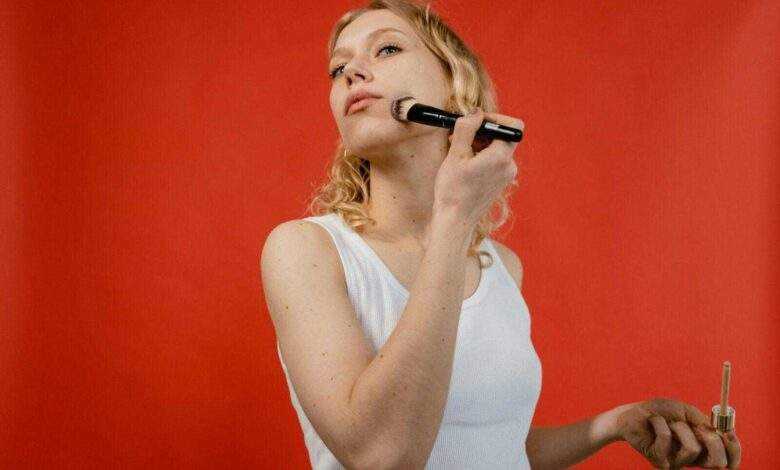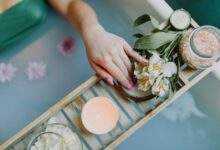DIY Natural Beauty Products: Simple Recipes for Healthy Skin and Hair

Table of Contents
The Allure of Natural Beauty
In recent years, there’s been a significant shift toward natural and organic beauty products, fueled by a growing awareness of the potential harms of synthetic chemicals found in conventional beauty items. Consumers are increasingly concerned about the long-term effects of harsh ingredients like parabens, sulfates, and synthetic fragrances on their skin, hair, and overall health. This trend has paved the way for a resurgence in DIY beauty practices, offering a safe, affordable, and enjoyable alternative.
DIY natural beauty products allow individuals to take control of what they apply to their bodies, ensuring that every ingredient is pure, beneficial, and free from harmful chemicals. Creating your own beauty products not only aligns with a healthier lifestyle but also taps into a creative and self-sustaining approach to personal care.
The Benefits of DIY Beauty
The appeal of DIY beauty products extends beyond avoiding harmful chemicals. Here are some compelling benefits:
- Customization for Specific Needs: One of the greatest advantages of DIY beauty products is the ability to tailor them to your unique skin and hair needs. Whether you have dry, oily, sensitive, or combination skin, you can create formulations that address your specific concerns.
- Control Over Ingredients and Quality: By making your own beauty products, you have full control over the quality and purity of the ingredients. You can choose organic, non-GMO, and ethically sourced components to ensure the highest standards.
- Cost-Effectiveness: Many DIY beauty recipes utilize common household ingredients, making them a cost-effective alternative to expensive commercial products. Buying ingredients in bulk can further reduce costs.
- Sustainability and Eco-Friendliness: DIY beauty practices contribute to a more sustainable lifestyle. By using natural ingredients and reusable containers, you can significantly reduce plastic waste and the environmental impact associated with conventional beauty products.
- The Satisfaction of Creating Your Own Products: There’s a unique sense of accomplishment and satisfaction that comes from crafting your own beauty treatments. It’s a creative process that connects you more deeply with your personal care routine.
Getting Started with DIY Beauty
Embarking on the DIY beauty journey is exciting, but it’s essential to start with the right knowledge and tools. Here are some fundamental tips for beginners:
- Basic Equipment and Supplies: Gather essential tools such as containers (glass jars, bottles), applicators (brushes, spatulas), mixing bowls, and measuring spoons. These items will help you mix, store, and apply your homemade products effectively.
- Safety Precautions: Always handle ingredients with care. Some essential oils and raw materials can cause irritation if used incorrectly. Conduct patch tests when trying new ingredients and follow recipes precisely to avoid adverse reactions.
- High-Quality Ingredients: Invest in high-quality, natural ingredients. Look for organic, cold-pressed oils, pure essential oils, and unrefined raw materials. The quality of your ingredients will directly impact the effectiveness and safety of your DIY beauty products.
- Following Recipes and Storage: Adhere to recipes accurately to ensure the right balance of ingredients. Proper storage is crucial for maintaining the freshness and efficacy of your products. Use clean, airtight containers and store them in cool, dark places to extend their shelf life.
A Peek at the Recipes to Come
In this blog, we’ll explore a variety of DIY beauty recipes that cater to different aspects of skin and hair care. From nourishing face masks and exfoliating scrubs to revitalizing hair treatments, each recipe is designed to enhance your natural beauty using simple, wholesome ingredients.
Key ingredients like honey, coconut oil, aloe vera, and essential oils will play a significant role in these recipes, each bringing unique benefits. Honey is a natural humectant, drawing moisture into the skin, while coconut oil provides deep hydration. Aloe vera soothes and heals, and essential oils offer a range of therapeutic properties.
DIY Face Care Recipes
A. Introduction to Face Care
A comprehensive skincare routine is essential for maintaining healthy, glowing skin. It involves cleansing, exfoliating, moisturizing, and treating the skin to address specific concerns. With the rise of natural beauty trends, DIY skincare products have become a popular alternative to commercial products. They offer the benefits of customization, natural ingredients, and cost-effectiveness, making them an excellent choice for anyone looking to enhance their skincare routine naturally.
B. Face Masks
Face masks are a fantastic way to provide intensive care for your skin. Different skin types require different treatments, and DIY masks allow you to tailor ingredients to meet your skin’s specific needs.
Hydrating Masks
For Dry Skin:
Honey and Aloe Vera Mask
- Ingredients:
- 2 tablespoons honey
- 2 tablespoons aloe vera gel
- Instructions:
- Mix honey and aloe vera gel in a bowl until well combined.
- Apply the mixture evenly to your face.
- Leave it on for 15-20 minutes.
- Rinse off with warm water and pat dry.
Cucumber and Yogurt Mask
- Ingredients:
- 1/2 cucumber, blended into a puree
- 2 tablespoons plain yogurt
- Instructions:
- Combine the cucumber puree and yogurt in a bowl.
- Apply the mask to your face, avoiding the eye area.
- Let it sit for 15 minutes.
- Rinse with cool water and pat dry.
Exfoliating Masks
For All Skin Types:
Oatmeal and Honey Mask
- Ingredients:
- 2 tablespoons ground oatmeal
- 1 tablespoon honey
- 1 tablespoon warm water
- Instructions:
- Mix the oatmeal, honey, and warm water to form a paste.
- Gently massage the paste onto your face in circular motions.
- Leave it on for 10 minutes.
- Rinse off with warm water.
Coffee Grounds and Coconut Oil Mask
- Ingredients:
- 2 tablespoons used coffee grounds
- 1 tablespoon coconut oil
- Instructions:
- Mix coffee grounds and coconut oil until well combined.
- Apply to your face and gently exfoliate in circular motions.
- Leave the mask on for 10 minutes.
- Rinse thoroughly with warm water.
Clay Masks
For Oily and Acne-Prone Skin:
Kaolin Clay and Tea Tree Oil Mask
- Ingredients:
- 2 tablespoons kaolin clay
- 1 tablespoon water
- 2-3 drops tea tree oil
- Instructions:
- Mix the kaolin clay and water until it forms a smooth paste.
- Add tea tree oil and mix well.
- Apply the mask to your face, avoiding the eye area.
- Let it dry for 10-15 minutes.
- Rinse with warm water and pat dry.
Bentonite Clay and Apple Cider Vinegar Mask
- Ingredients:
- 2 tablespoons bentonite clay
- 1-2 tablespoons apple cider vinegar
- Instructions:
- Combine bentonite clay and apple cider vinegar to form a paste.
- Apply to your face and leave it on until the mask dries (about 15 minutes).
- Rinse off with warm water.
Brightening Masks
For Dull Skin:
Lemon Juice and Yogurt Mask
- Ingredients:
- 1 tablespoon lemon juice
- 2 tablespoons plain yogurt
- Instructions:
- Mix lemon juice and yogurt until well combined.
- Apply the mask to your face.
- Leave it on for 10-15 minutes.
- Rinse with warm water.
Turmeric and Milk Mask
- Ingredients:
- 1 teaspoon turmeric powder
- 2 tablespoons milk
- Instructions:
- Mix turmeric and milk to form a paste.
- Apply the mask to your face, avoiding the eye area.
- Let it sit for 10 minutes.
- Rinse with warm water.
C. Cleansers and Toners
Gentle Cleansers
Coconut Oil Cleanser
- Ingredients:
- 1 tablespoon coconut oil
- Instructions:
- Massage coconut oil onto your face in circular motions.
- Let it sit for a minute or two.
- Wipe off with a warm, damp cloth.
Castile Soap Cleanser
- Ingredients:
- 2 tablespoons liquid castile soap
- 1/4 cup distilled water
- 5 drops essential oil (optional)
- Instructions:
- Mix all ingredients in a bottle and shake well.
- Use a small amount to cleanse your face, then rinse with water.
Natural Toners
Apple Cider Vinegar Toner
- Ingredients:
- 1 part apple cider vinegar
- 2 parts distilled water
- Instructions:
- Mix apple cider vinegar and water in a bottle.
- Apply to your face with a cotton ball after cleansing.
Witch Hazel and Rose Water Toner
- Ingredients:
- 1/4 cup witch hazel
- 1/4 cup rose water
- Instructions:
- Combine witch hazel and rose water in a bottle.
- Apply to your face with a cotton ball.
D. Moisturizers and Serums
Lightweight Moisturizers
Shea Butter and Jojoba Oil Moisturizer
- Ingredients:
- 1/4 cup shea butter
- 2 tablespoons jojoba oil
- Instructions:
- Melt shea butter in a double boiler.
- Remove from heat and stir in jojoba oil.
- Let it cool and solidify.
- Apply a small amount to your face after cleansing.
Targeted Serums
Vitamin E Oil Serum
- Ingredients:
- 2 tablespoons jojoba oil
- 1 tablespoon vitamin E oil
- 3 drops lavender essential oil (optional)
- Instructions:
- Mix all ingredients in a small bottle.
- Apply a few drops to your face and massage gently.
Hyaluronic Acid Serum
- Ingredients:
- 1/4 teaspoon hyaluronic acid powder
- 2 tablespoons distilled water
- Instructions:
- Dissolve hyaluronic acid powder in distilled water.
- Store in a dropper bottle.
- Apply a few drops to your face before moisturizing.
Relevant Websites and Online Resources
- Wellness Mama – A comprehensive resource for DIY natural beauty and wellness recipes.
- Hello Glow – Offers a variety of DIY beauty recipes and tips.
- The Natural Beauty Workshop – Provides detailed guides and recipes for making your own beauty products.
- The Humbled Homemaker – Features natural living and DIY beauty tutorials.
- Mountain Rose Herbs – A great source for high-quality, organic ingredients for DIY beauty products.
DIY Hair Care Recipes
A. Introduction to Hair Care
A proper hair care routine is essential for maintaining healthy, strong, and beautiful hair. While commercial hair products often contain harsh chemicals and synthetic ingredients, DIY hair care products offer a natural and customizable alternative. By using simple, natural ingredients, you can create effective hair treatments tailored to your specific hair type and concerns. Whether you have dry, oily, damaged, or colored hair, there’s a DIY recipe that can help address your needs.
B. Hair Masks
Hair masks are intensive treatments that can help nourish, repair, and rejuvenate your hair. Here’s a selection of hair masks categorized by hair type:
Moisturizing Masks
For Dry Hair:
Avocado and Coconut Oil Mask
- Ingredients:
- 1 ripe avocado, mashed
- 2 tablespoons coconut oil
- Instructions:
- Mash the avocado in a bowl until smooth.
- Add coconut oil and mix until well combined.
- Apply the mixture to your hair, focusing on the ends.
- Leave it on for 30 minutes.
- Rinse thoroughly with warm water and shampoo as usual.
- Recommended Frequency: Once a week.
Olive Oil and Honey Mask
- Ingredients:
- 2 tablespoons olive oil
- 1 tablespoon honey
- Instructions:
- Mix olive oil and honey in a small bowl.
- Apply the mixture to damp hair, from roots to ends.
- Cover your hair with a shower cap and leave it on for 20-30 minutes.
- Rinse with warm water and shampoo.
- Recommended Frequency: Once a week.
Strengthening Masks
For Damaged Hair:
Egg and Yogurt Mask
- Ingredients:
- 1 egg
- 1/4 cup plain yogurt
- 1 tablespoon honey
- Instructions:
- Beat the egg in a bowl, then add yogurt and honey.
- Mix until you have a smooth consistency.
- Apply the mask to your hair, concentrating on damaged areas.
- Leave it on for 20 minutes.
- Rinse with cool water and shampoo.
- Recommended Frequency: Once every two weeks.
Honey and Banana Mask
- Ingredients:
- 1 ripe banana, mashed
- 1 tablespoon honey
- 1 tablespoon coconut oil
- Instructions:
- Mash the banana in a bowl until smooth.
- Add honey and coconut oil, and mix well.
- Apply the mixture to your hair, focusing on the ends.
- Leave it on for 20-30 minutes.
- Rinse thoroughly with warm water and shampoo.
- Recommended Frequency: Once a week.
Hair Growth Masks
For All Hair Types:
Rosemary Oil and Coconut Milk Mask
- Ingredients:
- 2 tablespoons coconut milk
- 5 drops rosemary essential oil
- Instructions:
- Mix coconut milk and rosemary oil in a bowl.
- Apply the mixture to your scalp and hair.
- Massage gently for a few minutes.
- Leave it on for 30 minutes.
- Rinse with warm water and shampoo.
- Recommended Frequency: Once a week.
Peppermint Oil and Aloe Vera Mask
- Ingredients:
- 2 tablespoons aloe vera gel
- 5 drops peppermint essential oil
- Instructions:
- Mix aloe vera gel and peppermint oil in a small bowl.
- Apply the mask to your scalp and hair.
- Massage gently for a few minutes.
- Leave it on for 30 minutes.
- Rinse with cool water and shampoo.
- Recommended Frequency: Once a week.
Color-Enhancing Masks
For Colored Hair:
Beet Juice and Hibiscus Tea Mask
- Ingredients:
- 1/4 cup beet juice
- 1/4 cup brewed hibiscus tea, cooled
- Instructions:
- Mix beet juice and hibiscus tea in a bowl.
- Apply the mixture to your hair, focusing on colored areas.
- Leave it on for 20-30 minutes.
- Rinse with cool water and shampoo.
- Recommended Frequency: Once a month.
C. Hair Scrubs
Gentle Scalp Scrub
Sugar and Olive Oil Scalp Scrub
- Ingredients:
- 2 tablespoons granulated sugar
- 1 tablespoon olive oil
- 1 tablespoon coconut oil
- Instructions:
- Mix sugar, olive oil, and coconut oil in a bowl.
- Apply the scrub to your damp scalp.
- Massage gently in circular motions for a few minutes.
- Rinse thoroughly with warm water and shampoo.
- Recommended Frequency: Once a month.
D. Hair Rinses and Sprays
Natural Hair Rinses
Apple Cider Vinegar Rinse
- Ingredients:
- 1 part apple cider vinegar
- 3 parts water
- Instructions:
- Mix apple cider vinegar and water in a bottle.
- After shampooing, pour the mixture over your hair.
- Leave it on for a few minutes, then rinse with cool water.
- Recommended Frequency: Once a week.
Lemon Juice Rinse
- Ingredients:
- 1/4 cup lemon juice
- 3/4 cup water
- Instructions:
- Mix lemon juice and water in a spray bottle.
- Spray the mixture onto your hair after shampooing.
- Leave it on for 5 minutes, then rinse with cool water.
- Recommended Frequency: Once a week.
DIY Hair Sprays
Aloe Vera Hair Spray
- Ingredients:
- 1/2 cup aloe vera gel
- 1/2 cup water
- 5 drops lavender essential oil
- Instructions:
- Mix aloe vera gel, water, and lavender oil in a spray bottle.
- Shake well before each use.
- Spray onto damp or dry hair to add moisture and shine.
- Recommended Frequency: Daily or as needed.
Witch Hazel Hair Spray
- Ingredients:
- 1/2 cup witch hazel
- 1/2 cup distilled water
- 10 drops rosemary essential oil
- Instructions:
- Mix witch hazel, water, and rosemary oil in a spray bottle.
- Shake well before each use.
- Spray onto damp or dry hair for a refreshing boost.
- Recommended Frequency: Daily or as needed.
Relevant Websites and Online Resources
- NaturallyCurly – Offers a variety of natural hair care tips and DIY recipes.
- Wellness Mama – A comprehensive resource for DIY natural beauty and wellness recipes.
- Hello Glow – Provides a range of DIY beauty recipes, including hair care.
- The Natural Beauty Workshop – Features detailed guides and recipes for making your own beauty products.
- Mountain Rose Herbs – A great source for high-quality, organic ingredients for DIY beauty products.
DIY Body Care Recipes
A. Introduction to Body Care
Pampering your body with natural ingredients can be a luxurious and beneficial practice. Unlike commercial products laden with chemicals, DIY body care products allow you to customize treatments to suit your specific skin needs using pure, natural ingredients. These homemade remedies can help exfoliate, moisturize, and rejuvenate your skin, providing a healthier, more radiant appearance.
B. Body Scrubs
Exfoliating your skin with body scrubs can remove dead skin cells, improve circulation, and leave your skin feeling smooth and refreshed. Here are some recipes suitable for different skin types:
Sugar Scrubs for Overall Exfoliation
Vanilla Brown Sugar Scrub
- Ingredients:
- 1 cup brown sugar
- 1/2 cup coconut oil, melted
- 1 teaspoon vanilla extract
- Instructions:
- Mix brown sugar and coconut oil in a bowl.
- Add vanilla extract and stir until well combined.
- Apply to damp skin in circular motions, then rinse with warm water.
- Recommended Frequency: Once or twice a week.
Salt Scrubs for Invigorating and Detoxifying Effects
Sea Salt and Lemon Scrub
- Ingredients:
- 1 cup sea salt
- 1/2 cup olive oil
- Juice of one lemon
- 1 tablespoon lemon zest
- Instructions:
- Combine sea salt and olive oil in a bowl.
- Add lemon juice and zest, mixing well.
- Gently scrub onto damp skin and rinse with warm water.
- Recommended Frequency: Once a week.
Coffee Scrubs for Cellulite Reduction and Improved Circulation
Coffee and Coconut Oil Scrub
- Ingredients:
- 1/2 cup coffee grounds
- 1/4 cup coconut oil, melted
- 1/4 cup brown sugar
- Instructions:
- Mix coffee grounds, coconut oil, and brown sugar in a bowl.
- Apply the scrub to damp skin, massaging in circular motions.
- Rinse with warm water.
- Recommended Frequency: Once or twice a week.
C. Body Butters and Lotions
Moisturizing your skin with body butters and lotions can help keep it hydrated and soft. Here are some recipes for luxurious body butters and lightweight lotions:
Luxurious Body Butters
Whipped Shea Butter Body Butter
- Ingredients:
- 1/2 cup shea butter
- 1/4 cup coconut oil
- 1/4 cup almond oil
- 10 drops essential oil (lavender, peppermint, etc.)
- Instructions:
- Melt shea butter and coconut oil in a double boiler.
- Remove from heat and stir in almond oil.
- Let the mixture cool until it begins to solidify.
- Whip with a hand mixer until light and fluffy.
- Add essential oil and mix well.
- Store in a glass jar and use as needed.
- Recommended Frequency: Daily.
Lightweight Body Lotions
Aloe Vera and Almond Oil Lotion
- Ingredients:
- 1/2 cup aloe vera gel
- 1/4 cup almond oil
- 10 drops essential oil (chamomile, lavender, etc.)
- Instructions:
- Mix aloe vera gel and almond oil in a bowl.
- Add essential oil and stir until well combined.
- Pour into a pump bottle and apply as needed.
- Recommended Frequency: Daily.
D. Bath Soaks and Salts
Relaxing bath soaks and salts can help soothe muscles, detoxify the body, and promote relaxation. Here are some recipes to try:
Relaxing Bath Soaks
Lavender Epsom Salt Soak
- Ingredients:
- 1 cup Epsom salts
- 1/2 cup baking soda
- 10 drops lavender essential oil
- Instructions:
- Mix Epsom salts and baking soda in a bowl.
- Add lavender essential oil and stir well.
- Add to a warm bath and soak for 20-30 minutes.
- Recommended Frequency: Once a week or as needed.
Invigorating Bath Salts
Citrus Sea Salt Bath
- Ingredients:
- 1 cup sea salt
- 1/2 cup baking soda
- Zest of one orange
- Zest of one lemon
- 10 drops citrus essential oil
- Instructions:
- Mix sea salt, baking soda, and citrus zest in a bowl.
- Add citrus essential oil and stir until well combined.
- Add to a warm bath and soak for 20-30 minutes.
- Recommended Frequency: Once a week or as needed.
E. Lip Scrubs and Balms
Keeping your lips smooth and hydrated is easy with DIY lip scrubs and balms. Here are some nourishing recipes:
Gentle Lip Scrubs
Brown Sugar and Honey Lip Scrub
- Ingredients:
- 1 tablespoon brown sugar
- 1 tablespoon honey
- 1/2 teaspoon coconut oil
- Instructions:
- Mix brown sugar, honey, and coconut oil in a small bowl.
- Gently massage the scrub onto your lips in circular motions.
- Rinse with warm water.
- Recommended Frequency: Once or twice a week.
Nourishing Lip Balms
Beeswax and Shea Butter Lip Balm
- Ingredients:
- 1 tablespoon beeswax pellets
- 1 tablespoon shea butter
- 1 tablespoon coconut oil
- 5 drops essential oil (peppermint, vanilla, etc.)
- Instructions:
- Melt beeswax, shea butter, and coconut oil in a double boiler.
- Remove from heat and add essential oil.
- Pour the mixture into lip balm tubes or small containers.
- Let cool and solidify before use.
- Recommended Frequency: Daily or as needed.
Relevant Websites and Online Resources
- Wellness Mama – Offers a variety of DIY body care recipes and natural wellness tips.
- The Natural Beauty Workshop – Provides detailed guides and recipes for creating your own body care products.
- Mountain Rose Herbs – A source for high-quality, organic ingredients for DIY body care products.
- Hello Glow – Features a range of DIY beauty recipes, including body scrubs, butters, and balms.
- Mind Body Green – Offers insights and recipes for natural beauty and holistic wellness.
Additional Tips and Tricks for DIY Natural Beauty Products
Creating your own beauty products can be a fulfilling and enjoyable experience. Here are some additional tips and tricks to enhance your DIY beauty routine.
A. Essential Oils for DIY Beauty
Benefits and Safe Use of Essential Oils:
Essential oils offer a wide range of benefits for your skin and hair. They are highly concentrated plant extracts that can provide therapeutic properties, wonderful fragrances, and natural preservation.
- Safe Use:
- Always dilute essential oils in a carrier oil (e.g., coconut oil, almond oil) before applying to the skin to prevent irritation.
- Perform a patch test to check for any allergic reactions.
- Use essential oils in moderation, as they are potent.
Recommended Essential Oils for Different Purposes:
- Lavender Oil:
- Benefits: Relaxation, calming, and soothing skin irritations.
- Uses: Add to bath soaks, lotions, and sleep sprays.
- Tea Tree Oil:
- Benefits: Antimicrobial, anti-inflammatory, and acne-fighting properties.
- Uses: Incorporate into facial cleansers, spot treatments, and scalp scrubs.
- Peppermint Oil:
- Benefits: Stimulates hair growth, cooling effect, and relieves headaches.
- Uses: Use in hair masks, scalp treatments, and foot scrubs.
- Rosehip Oil:
- Benefits: Rich in vitamins A and C, promotes skin regeneration, and reduces scars.
- Uses: Add to face serums, moisturizers, and body oils.
B. Finding and Selecting High-Quality Ingredients
Sourcing High-Quality Natural Ingredients:
- Online Retailers:
- Mountain Rose Herbs: Offers a wide range of organic and high-quality ingredients.
- Bulk Apothecary: Supplies essential oils, carrier oils, and other DIY beauty ingredients.
- Amazon: Provides a variety of natural ingredients, but always check reviews and ratings.
- Local Health Food Stores:
- Visit local health food stores or co-ops that carry organic and food-grade ingredients.
- Farmers markets can also be a source for fresh and locally sourced ingredients like honey and herbs.
Checking Expiration Dates and Ensuring Quality:
- Always check the expiration dates of ingredients to ensure freshness and effectiveness.
- Choose organic or food-grade ingredients when possible to avoid pesticides and harmful chemicals.
- Store ingredients properly to extend their shelf life (e.g., keeping oils in dark, cool places).
C. Packaging and Gifting Your DIY Creations
Creative and Eco-Friendly Packaging Ideas:
- Glass Jars and Bottles:
- Use mason jars, amber bottles, or clear glass containers to store your DIY beauty products.
- Decorate with labels, ribbons, and twine for a personal touch.
- Recycled Containers:
- Reuse containers from store-bought products after thoroughly cleaning them.
- Decorate with washi tape, stickers, and custom labels.
Turning Your Creations into Thoughtful Gifts:
- Create gift sets with a theme (e.g., a relaxation set with bath salts, body butter, and a sleep spray).
- Personalize gifts by adding the recipient’s favorite scents or ingredients.
- Include a handmade card with instructions and benefits of the products.
D. Troubleshooting Common DIY Beauty Issues
Common Problems and Solutions:
- Achieving Desired Consistency:
- If a product is too thick, add more carrier oil or aloe vera gel.
- If too runny, add more solid ingredients like shea butter or beeswax.
- Skin Irritation:
- Always perform a patch test before using a new product.
- Reduce the amount of essential oils or switch to gentler oils like chamomile or rose.
- Preservation:
- Use natural preservatives like vitamin E oil or rosemary extract to extend shelf life.
- Store products in the refrigerator if they contain water-based ingredients to prevent mold growth.
- Customization:
- Feel free to experiment with different ingredients to suit your specific needs.
- Keep a journal of your recipes and any adjustments made for future reference.
Relevant Websites and Online Resources
- The Essential Oil Company – Offers high-quality essential oils and DIY beauty recipes.
- DIY Natural – Provides a variety of DIY beauty and household recipes.
- Herbivore Botanicals Blog – Features tips on natural skincare and DIY beauty recipes.
- Bramble Berry – Supplies ingredients and tutorials for making your own beauty products.
- Hello Glow – Offers numerous DIY beauty recipes and wellness tips.
Creating your own natural beauty products at home offers numerous benefits. DIY beauty allows you to customize products to fit your specific skin and hair needs, ensuring that you’re only using high-quality, safe, and natural ingredients. This personalization is not only beneficial for your beauty routine but also promotes sustainability and cost-effectiveness. By avoiding the harsh chemicals found in many commercial products, you can achieve healthier skin and hair while also contributing to a greener planet.
The process of making DIY beauty products is straightforward and enjoyable. With just a few basic tools and ingredients, you can create a wide range of products, from face masks and cleansers to hair masks and body scrubs. The satisfaction of crafting your own beauty solutions is immense, and the knowledge that you’re using wholesome, natural ingredients brings peace of mind.
The Future of DIY Beauty
The trend towards DIY beauty is growing rapidly, as more people become aware of the potential harms of synthetic ingredients and the benefits of natural alternatives. This movement empowers individuals to take control of their beauty routines, fostering a deeper connection to the products they use and the ingredients they apply to their bodies.
As you become more experienced with DIY beauty, there’s a wealth of advanced recipes and techniques to explore. From formulating your own serums to creating personalized blends of essential oils, the possibilities are endless. The DIY beauty community is vibrant and supportive, offering countless resources, forums, and tutorials to help you refine your skills and expand your repertoire.
Now that you’ve learned about the benefits and ease of creating DIY natural beauty products, it’s time to embark on your own DIY journey. Start with a few simple recipes from this blog and experience the joy of crafting personalized beauty solutions. Share your creations with friends and family, and encourage them to join you in making the switch to natural, homemade products.
As you experiment with different recipes, feel free to adjust ingredients and methods to suit your preferences. Keep track of your favorite combinations and take pride in the knowledge that you’re contributing to a healthier lifestyle and a more sustainable world.
To get started, gather the basic supplies and ingredients mentioned in this blog. Choose a few recipes that appeal to you, and follow the detailed instructions provided. Don’t be afraid to get creative and have fun with the process. As you gain confidence and experience, try more advanced recipes and experiment with new ingredients and techniques.
DIY Natural Beauty Q&A: Unleash Your Inner Alchemist!
Welcome to the world of DIY natural beauty! We know you might have questions as you embark on this exciting journey. This FAQ section addresses some of the most common inquiries to empower you on your DIY path:
1. Are DIY natural beauty products safe?
Yes, but with a caveat! Natural ingredients can be incredibly safe and gentle, but caution is always key. Here’s what to consider:
- Research ingredients: Learn about potential allergies or sensitivities you might have to specific ingredients.
- Source high-quality ingredients: Choose organic or food-grade options whenever possible to minimize exposure to harmful chemicals.
- Start with a patch test: Before applying a new product to your face, apply a small amount to your inner arm and wait 24 hours to check for any irritation.
- Follow recipes accurately: Don’t substitute ingredients without research, as some combinations can be ineffective or even harmful.
2. What if I have no experience with DIY beauty? Where do I begin?
No worries! DIY beauty is perfect for beginners. Here’s how to get started:
- Start simple: Choose recipes with a few easy-to-find ingredients. Explore our blog post “Top 5 Easy DIY Beauty Recipes for Beginners” for a gentle introduction.
- Invest in a few basic tools: Mixing bowls, spoons, and airtight containers are all you need to get started.
- Do your research: Many websites offer comprehensive guides and tutorials on DIY beauty. Explore our website for a wealth of information!
3. How long do homemade beauty products typically last?
The shelf life of your creations depends on the ingredients. Generally, products with high water content (like masks) will have a shorter lifespan (1-2 weeks). Here are some tips for maximizing shelf life:
- Use clean, sterilized equipment: This helps prevent bacterial growth.
- Add a natural preservative: Vitamin E oil or rosemary extract can extend shelf life.
- Store products in airtight containers: This minimizes exposure to light and air, both of which can degrade ingredients.
- Label your creations with the date of manufacture: This helps you track their lifespan.
4. What are some essential tools to have on hand for DIY beauty projects?
While you can get started with very little, having a few basic tools will make your DIY experience smoother:
- Mixing bowls and spoons: Choose various sizes depending on the recipe. Glass or stainless steel bowls are easiest to clean and sterilize.
- Measuring cups and spoons: Ensure accurate measurements for successful results.
- Airtight containers: Store your finished products in containers that minimize exposure to air and light. Glass jars with lids work well.
- Mortar and pestle (optional): This tool is handy for grinding herbs or spices used in some recipes.
- Whisk (optional): Useful for whipping ingredients or creating a smooth consistency.
5. Can I use expired ingredients in my DIY recipes?
It’s best to avoid using expired ingredients in your DIY beauty products. Here’s why:
- Loss of potency: Over time, ingredients can lose their effectiveness, making your product less beneficial.
- Increased risk of bacteria: Expired ingredients might harbor bacteria that can cause skin irritation or even infections.
- Changes in consistency: Expired ingredients may change texture or separate, impacting the final product.
6. Is it safe to use essential oils in DIY beauty products?
Essential oils can be wonderful additions to DIY beauty products, offering specific benefits like relaxation or promoting hair growth. However, they are highly concentrated and require caution:
- Dilution is key: Essential oils should always be diluted in a carrier oil (like almond oil or jojoba oil) before applying them to the skin.
- Research individual oils: Some essential oils can be irritating or even toxic if not used properly. Research each oil before incorporating it into a recipe.
- Perform a patch test: Even diluted oils can cause reactions. Apply a small amount of the diluted oil on your inner arm and wait 24 hours before using it on a larger area.
7. How can I creatively package my DIY creations for gifts?
Homemade beauty products make fantastic gifts! Here are some ideas for creative packaging:
- Mason jars: These are versatile and can be decorated with ribbons, fabric scraps, or personalized labels.
- Recycled containers: Repurpose pretty tins or glass bottles, giving them a new lease on life.
- Small baskets: Fill a basket with your creations and add natural embellishments like dried flowers or herbs.
- Fabric pouches: Sew or purchase cute fabric pouches for a touch of personalization.
8. I’m interested in making DIY hair care products. What are some good beginner recipes?
Hair care is a great place to start with DIY beauty! Here are some beginner-friendly recipes to try:
- Deep conditioning hair mask with avocado and honey: Nourishes dry, damaged hair.
- Scalp scrub with brown sugar and coconut oil: Exfoliates and promotes healthy hair growth.
- Shine spray with apple cider vinegar and water: Adds natural shine and tames frizz.
9. What are some common mistakes to avoid when making DIY beauty products?
Here are some common pitfalls to avoid for successful DIY beauty ventures:
- Not following recipes precisely: Accurate measurements and ingredients are crucial for achieving desired results.
- Using unclean equipment: Sterilize your tools to prevent bacterial contamination.
- Overusing essential oils: Remember, dilution is key to avoid irritation.
- Not storing products properly: Exposure to light, air, and heat can shorten shelf life.
10. Where can I find inspiration for new DIY beauty recipes?
The world of DIY beauty is vast and exciting! Here are some resources for inspiration:
- Beauty blogs and websites: Many websites offer a wealth of DIY recipes and tips.
- Books on DIY beauty: Explore libraries or bookstores for in-depth guides and recipe collections.
- Social media: Follow DIY beauty enthusiasts on platforms like Instagram or Pinterest for inspiration and ideas.








